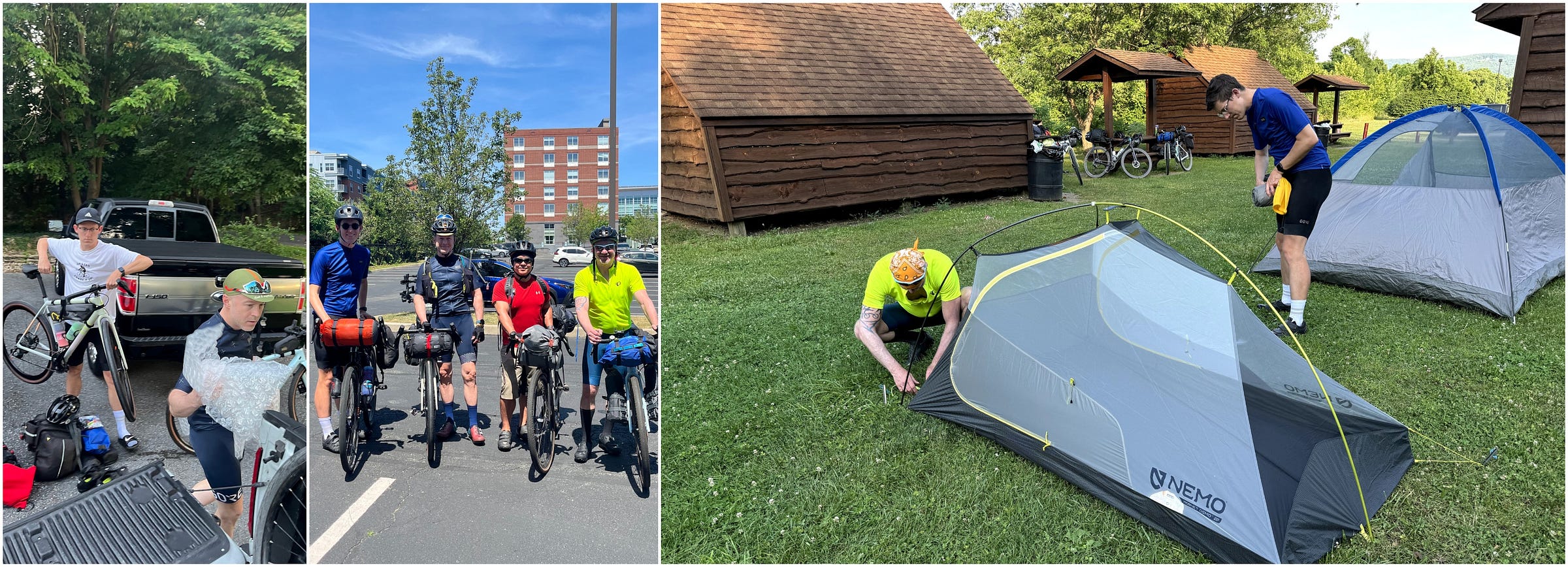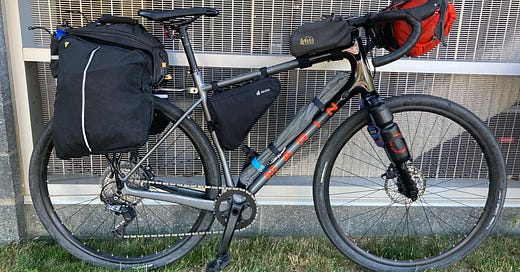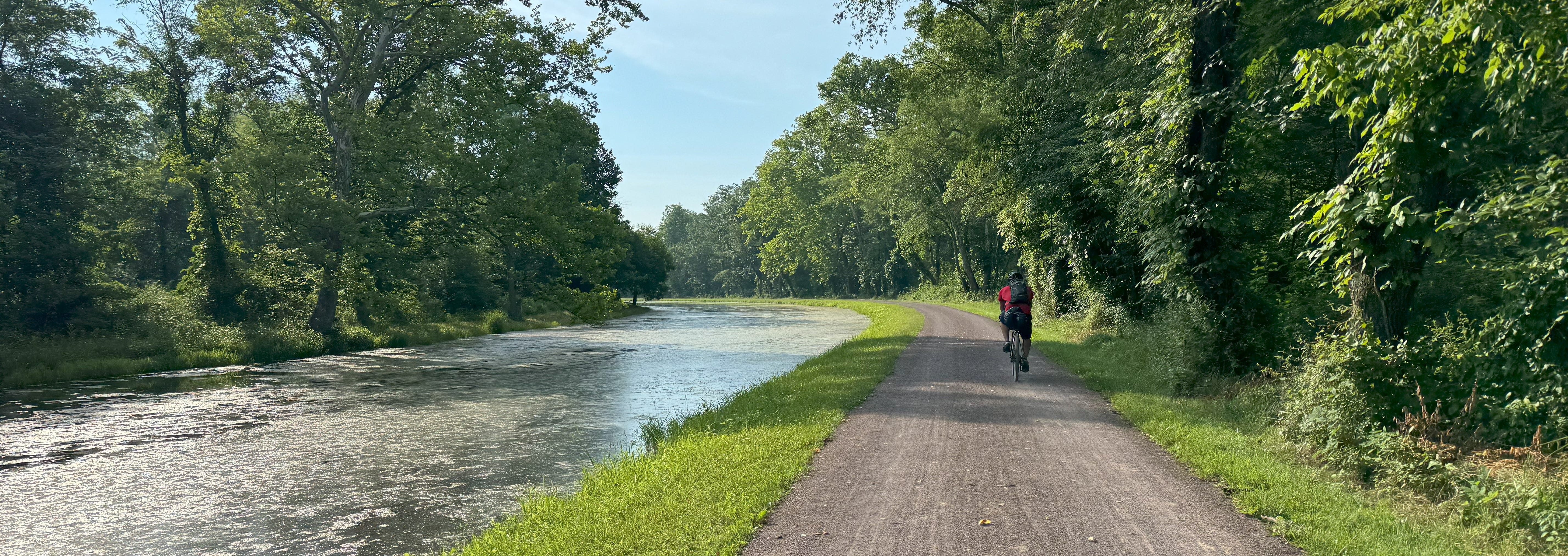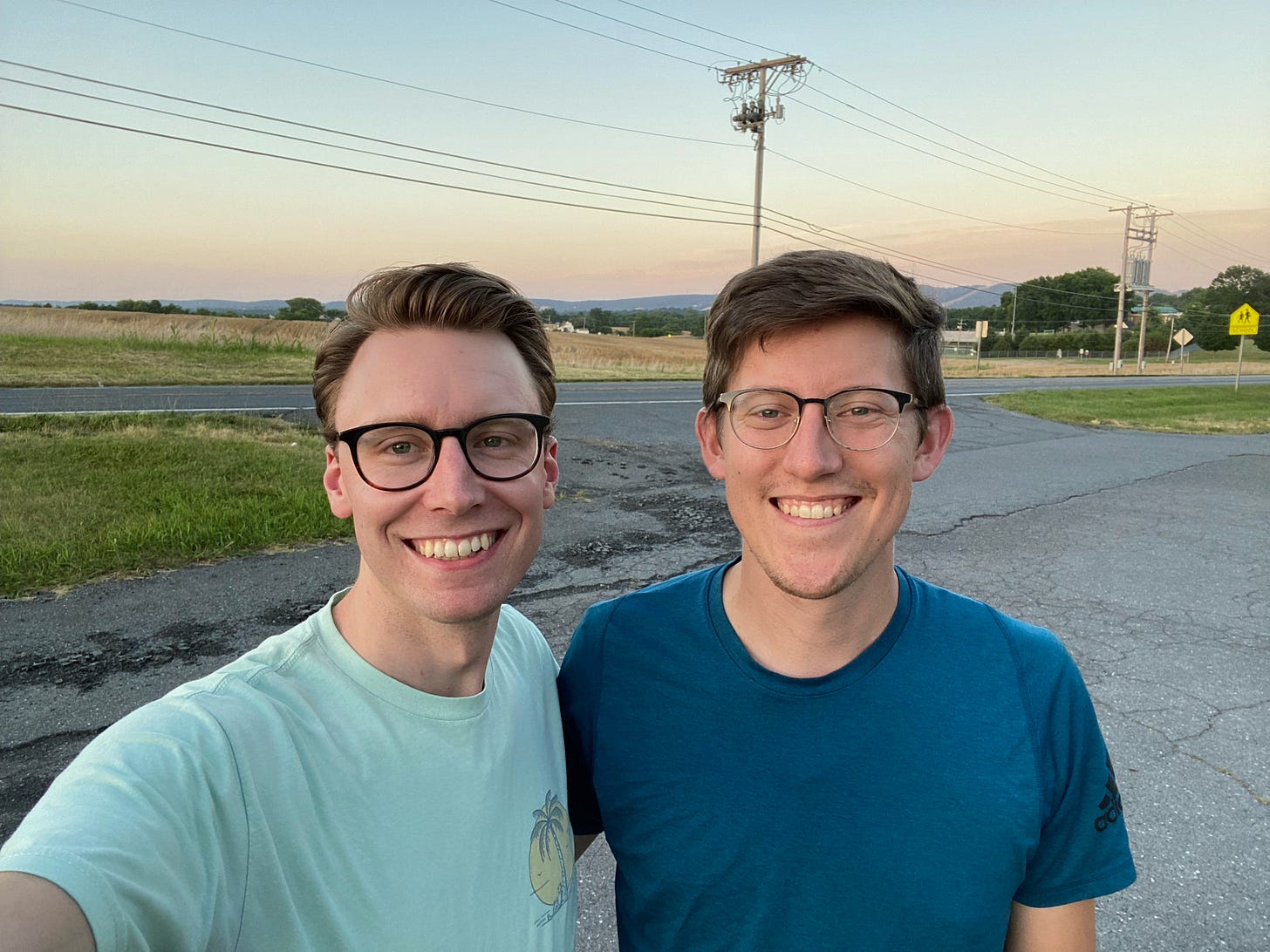You’re reading From the Desk, a monthly newsletter about art, spirituality, and the good life.
This June, three friends (two coworkers, Jonathan and Joe, and Jonathan’s neighbor Patrick) and I biked from Pittsburgh, PA to Washington, D.C., a journey of 340 miles over six days following two major gravel trails and strapping to our bikes much of the necessary gear to get us through the week.
What inspired the urge to pack up our minimal belongings and set out in what the news began calling the apocalyptic “heat dome” that would choke the East Coast during our ride, a week so hot that evaporated water couldn’t make it up to the clouds to form rain? Was it an excuse to buy new gear? Not exactly, though I’ll never complain about another trip to REI. Was it to test our limits, see what metal we were made of? No again. The trail was relatively flat and our journey well-paced.
The truth is, a multi-day trip like this one, whether on foot, boat, or bike can hold the weight of many different expectations. Each day contains its own little victories and satisfactions. I had several hopes—to enjoy the sheer amount of time on the bike, to bask in the beauty of dense hills and calm rivers, to admire the small towns, and to camp and swim and rough it when I could.
Itinerary
Pittsburgh, PA to Connellsville, PA (55 Miles)
Connellsville, PA to Rockwood, PA (45 Miles)
Rockwood, PA to Spring Gap, MD (55 Miles)
Spring Gap, MD to Big Springs, MD (65 Miles)
Big Springs, MD to Brunswick, MD (55 Miles)
Brunswick, MD to Washington, D.C. (55 Miles)
Gear
Bike: Marin Headlands 1
I love this bike. Fairly affordable for a carbon frame, with lots of attachment points. Didn’t experience a single mechanical issue all week.
Waterbottles on both front forks
Aeroe Spider Handlebar Cradle (for sleeping bag)
Rei Co-Op Junction Top Tube Bag (snack, multi-tool, spare tube, phone)
Deuter 2.2 Triangle Bag (for food)
Custom Mini Cages
Holding my tent poles was one of the bigger challenges. The tent I have is light enough but not made for packing down small. The poles are 20 inches long which would stick out just about anywhere on the bike. Luckily my frame is large and has mounts on the down-tube. I asked my buddy Isaac Litster to make some little cages for me that would allow me to strap the pole bag down to the frame without scratching up the carbon. He made me an aluminum and 3D-printed version. Both worked like a dream.
Topeak Explorer Disc II (to hold the rear bag/panniers)
Topeak MTX Trunkbag EXP (clothes and sleeping pad in one pannier, tent body in the other, and food, chargers, and misc. items in the center.
The other main challenge was getting my bike out east. I didn’t want to rent one since I had just bought the Marin. I opted for a Dakine Bike Roller Bag and flew a connecting flight both ways with no complications.
Day 1: From City, to City, to Countryside
I arrived the night before at Baltimore-Washington International with my bike bag, the tires, handlebars, derailleur, and pedals removed, the frame cushioned in the middle, and the rest of my gear stuffed into a single medium-sized suitcase. After a night at Jonathan’s, we woke up early, put the bikes in the rental truck, and left for Pittsburgh, a three-and-a-half-hour drive away. It was odd to think what would take us a single morning in the car, cruising at 75 down the Pennsylvania Turnpike, would require the rest of the week to get back.
Pittsburgh marks the start of the Great Allegheny Passage (GAP Trail), an old railroad that’s been converted into a finely maintained gravel path that climbs gradually as it runs to the Eastern Continental Divide and then descends quickly into Cumberland, MD.
Pittsburgh is an old city, not in the European sense, with castles and cobblestones, but in an industrial sort of way, home to hundreds of steel bridges, delipidated factories, and massive river ports, furnaces, and rail houses, the rusted bones of old commerce. Even the new factories built between the old ones create the kind of materials you’ll never think about and never see—pipes and fittings and chemicals.

Juiced with months of anticipation, we shot out of the city into a headwind on the banks of the Monongahela River. We were going so fast, I didn’t realize I was running over an exceptionally chunky marmot (who had timed his trail crossing at the wrong moment) until he was under my front tire and about to catch my rear one square on his back. The rest of the group dodged the poor critter, and he scampered into the woods, hopefully just a little sore.
The heat had already started, but we didn’t notice it much until lunch at a small sandwich, wings, and pizza joint in Beuna Vista with no indoor seating. When on the trail, the wind, tree cover, and proximity to the rivers kept us cool. Any stop, especially one off the trail, made us sweat instantly.
After 55 miles of riding, we camped that night at a free hiker/biker stop near the edge of Connellsville, PA, enjoying a dip in the Youghiogheny River and walking distance to a grocery store for gallon jugs of water, fresh fruit, and breakfast the next morning.
Day 2: The Hill That Never Ends
Sleeping in the tent was brutal. Besides the regular symphonies of snores and the swish of sleeping bag adjustments, the park was full of noise from passing trains still insistent on blaring their horn, cars screeching in the distance, and a random garbage man who decided midnight was the ideal time to collect from the bins in the camp. The night was hot, not dipping below 70 degrees until what felt like morning.
Today would be our shortest day of riding, just 45 miles, but over that stretch, we’d climb a not-insignificant 1,000 feet. That may not seem like much, and it really wasn’t (though an additional 30 pounds of gear doesn’t help), but what was most odd was the consistency of the gradual rise, a mere .5-1% gradient the entire time. Most trails have a variety of ups and downs that keep things interesting. This trail, especially the 20 or so miles we rode after lunch, never undulated.
It felt as if the mind was playing tricks on you. The path ahead would curve gently into the trees and you were sure that around the corner you would crest the little hill. Yet around the turn, the same thing happened, just another slight incline bending once again out of sight. This continued for hours, making it feel as though we were on some never-ending hill.
The scenery on this stretch was among my favorite. After we left Connellsville, we entered a more forested area, part State Game land, part belonging to Ohiopyle State Park. The trees were thicker, small streams ran down the steep hills on either side, and giant rhododendron bushes lined the path.
As we neared Ohiopyle, Pennsylvania’s whitewater area, we crossed huge bridges spanning the river and entered a region called the Laurel Highlands, our home until the Maryland border the next day.
The afternoon’s climb was broken up by our best swimming experience. A biker on the trail told us about a walkway down to the Casselman River and waited for us a few miles ahead to show us the spot. It was a perfect swimming hole, rocky and secluded.
That night we stayed at the Trailhouse Bed and Breakfast in the quaint town of Rockwood, home to no restaurants open on a Monday. And so we sat around the esteemed dining room table eating our dehydrated dinners. The stay gave us a chance to shower, wash some clothes, and enjoy eight hours of sleep in an air-conditioned room.
Day 3: Crossing the Mason-Dixon
The long, drawn-out hill continued another 20 miles, but once we hit the Eastern Continental Divide, things got much faster, and we passed a string of the more significant landmarks of the trip, the Eastern Continental Divide being one of them, followed by the Big Savage Tunnel. The tunnel was the longest of the trail at around 3,200 feet. It loomed tall and imposing before us, draped in green ferns and foliage, the other side invisible from our view. Equally imposing was the chilly air billowing from the dark chamber. From about 30 feet away you could feel it hit you, and once inside, the temperature dropped significantly, so that any sweat and humidity seemed to freeze on your body as you raced through the darkness.
A few miles later, we hit the Mason-Dixon Line. I get stupidly excited every time I see the Mason-Dixon. The history of the line is at least a hundred years older than anything else we saw on the trail, and up here in the hills, it’s rather arbitrary, not following any ridge line, valley, or river.

We ripped down the hill, stopping one more time in Frostburg, MD for lunch at a hamburger stand before reaching Cumberland, the end of the GAP trail and the beginning of the Chesapeake and Ohio Canal (C&O). Cumberland is picturesque, with steeples and old buildings popping up against the backdrop of the Appalachians. 95% of the town is also built of brick, and it was unbearably hot in the city.
There isn’t much fanfare between the beginning of one trail and the start of the next. Really, the only noticeable difference is the quality of the trail. The C&O is managed by the National Parks Service which takes a hands-off approach to maintenance. We only went 12 miles on the trail until the Spring Gap Hiker/Biker campground, but they were by far among the worst 12 miles of trail on the entire trip. It was lucky, actually, that things had been so hot because any amount of rain turns this section of the trail into a mud pit.
After we set up camp, Patrick and I biked up the hill to a small Mennonite deli and loaded up on sandwiches, chips, two gallons of water, and a bag of ice. After a post-dinner swim in the Potomac, we had a sleepless night in the hot tent.
Day 4: Paw Paw and an Asphalt Reprieve
We got an early start in the morning, conscious of the fact that this would be our longest day with 65 miles of riding. As it would turn out, my hind parts would never fully recover after today. The legs were strong but so much time in the saddle had taken its toll, and there was a persistent soreness going forward.
We made it to Paw Paw, WV, a small, depressed town across the bridge, and ate an early lunch at the gas station as the local retirees oggled at us over their cigarettes.
Paw Paw is also the name of the largest tunnel on the C&O. Unlike the GAP Trail tunnels, this one was unlit, though you could barely make out the light on the other side. Also unique to the C&O, the canal runs through the tunnel, and the trail is about six feet up on the side, separated by a wooden fence.

About 30 miles into the day, the trail detoured us off the C&O and onto the neighboring Western Maryland Rail Trail. This trail isn’t long, but it is paved, and by this point, none of us were too proud to get off the gravel for a little tarmac. We flew into Hancock for another half lunch, and then another 10 miles further until the trail ended and we rejoined the C&O.
That night we stayed in the most historical of our stops, Lockhouse 49. The Parks Service, in addition to maintaining the trail, also maintains a number of old houses that once housed the families who ran the locks outside their front door, allowing canal boats to gradually descend and ascend the changing elevation alongside the river. Preserved in mostly their original state, they make for memorable stops when riding on the C&O.
The house was absolutely cooking in the heat—I would guess the bedrooms upstairs were close to 85 degrees at 9 pm. We hauled down the well-worn mattresses and fans (our house had electricity, but not running water), and slept in the kitchen and living room where it was slightly cooler.
Day 5: You’ve Got to Earn Your Rest
It was a quick 10 miles into Williamsport, MD in the morning for a pitstop at Sheetz for water, ice, and a place to dispose of last night’s trash (no trash on the trail!). I’d never been to Williamsport before, but it’s a charming little town, much nicer than Hancock, with a little downtown and easy access to the trail.

After so many days on these trails, the scenery was beautiful yet beginning to blend together. In the summer, the C&O is unkept and wild, with vines and trees and rocky enclaves shrouding the trail. All the greenery makes it hard to see the river, and at times you feel like you’re in a jungle, always waiting for the bracken to give way to a vista that never comes.
It was with some relief that we went past one of the more interesting parts of the trail, Big Stillwater, a quiet section of the Potomac created by a dam upstream. The canal ends and the boats would join the river for a few miles until a river lock would bring them back off the main flow and the canal resumed. It was refreshing to have such open space and proximity to the river.
Our last stop of the day before the hotel was over a large bridge into Shepherdstown, WV. It may be the nicest little city in the state, a sort of hippy enclave with cute shops and great restaurants, including the Blue Moon cafe where I had the most amazing steak and cheese sandwich of my life.
Harper’s Ferry, another great West Virginia town is only a few miles downriver, but getting over to it requires hiking up a huge staircase with the bikes. Three of us had taken our first bikepacking trip from Harper’s Ferry two years ago, so we rode on without stopping.
Hot and ready to leave the trail, we were dismayed to discover that our hotel was at the top of a monster hill in Brunswick, MD. The reward of hot food, hot showers, and eight hours of sleep in air conditioning made the climb well worth it.
At this point, I was getting close to my old home in Germantown, and my great friend Nate Benfell was able to drive over to Brunswick on short notice to join me for dinner. What an unexpected highlight of the trip to get two hours with him!
Day 6: What Doesn’t Kill You…
We took our time at breakfast in the diner by the hotel and set off to Washington D.C. a little before 10 am. Someone was scheduled to pick us up but couldn’t arrive until after 5 pm. With only 55 miles to go, we didn’t want to sit outside in the heat all afternoon. Unfortunately, this meant the sun was already baking the dusty trail as we began.
We had debated the whole time whether we’d be stronger and adapted to the bike by the end, or whether we’d be dead tired. Funnily, it was a mix of both. My legs were starting to cramp a little but didn’t feel painful. My butt was toast—even a good night’s sleep in a cushy hotel couldn’t restore me. I think for all of us, while the only thing on our minds was finishing the trip and taking a break from biking, there was a bittersweet feeling about this being the end. It’s not often that you get to spend six days on your bike with no responsibilities besides hydration, food, and a place to sleep.

We passed some notable sites—the Monocacy Aqueduct, White’s Ferry (our lunch stop for the day), and most scenic, Great Falls, my favorite spot on the Potomac. There was no way I was getting off the bike to walk out to the falls, though.
It was so hot and the trail so shoddy in the last 15 miles toward D.C., all we could do was keep our head down and pedal until we finally reached Georgetown and the underpass beneath the Whitehurst Freeway (technically on the paved Capitol Crescent Trail).
The trip was over. As we sat outside a Starbucks with a celebratory smoothie, I kept thinking people should be coming up and congratulating us. It was not to be, and so we slurped down the slush in our lycra and scooted off to the subway.
Parting Thoughts
In the end, there’s not much to say except how much I enjoyed the trip. Like most experiences in my life, I looked for deeper meaning on the trail, both in the way of metaphor and revelation amidst so much time to ponder. No big inspiration came my way, unlike my rafting trip last year when I felt our family should move back West. By way of metaphor, the best I could come up with was that: that preparation, surrounding yourself with good company, being flexible with yourself, expectations, and others, and pedaling until you reach the end makes for a decent comparison to life.
What sticks out most is how much fun the whole thing was. I loved being back East, loved the trail, the small towns, the stupid jokes with Jonathan, Joe, and Patrick.
There’s no right way to bike pack. We saw retirees on e-bikes with support vehicles, a young couple stopping at every historical site on the way, plenty of folks who opted for hotels, and many who didn’t. Some biked fast, others biked slow. It’s probably the easiest way to see a lot of beautiful nature without killing yourself physically.
If you want to learn more about bike packing or plan a trip, let’s chat!









Loved this newsletter!! You are an amazing writer and have great content, so I always love your emails. This one resonated with me! Thanks for sharing, my friend.